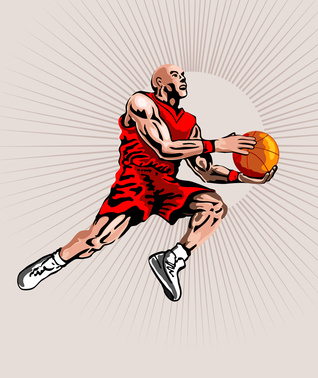
Overview
Basketball is a game that combines aerobic and anaerobic characteristics. Replete with bouts of jogging, running and sprinting, it is a game that mimics interval-style training. Performance relies heavily on muscular strength, muscular endurance, cardiorespiratory fitness and flexibility. Quickness, agility and power are the other characteristics necessary for jumping, shooting and maintaining a defensive posture. Appropriate training and conditioning for the game of basketball should include total body strength training, plyometric training and near maximal, high-intensity endurance exercises.
Types of Strength Training
Strength and mass are essential for basketball, especially for the taller players that spend most of the time in the low post area and are in constant contact with the opposing player. Olympic-style weight-lifting is central to improving strength. These are multi-joint exercises that typically work more than one muscle group at a time. Examples of Olympic lifts include the clean, hang clean, push press and snatch. Execution of these moves mimics movements necessary for basketball.
Plyometric Training
Plyometric can be interpreted to mean "measurable increases." The goal of plyometric training is to teach muscles to reach maximum strength in the shortest time possible. This type of training is for explosive power, which is integral to jumping for rebounds or to block shots in basketball. Standing jumps, multiple jumps, box drills, bounding and depth jumps are some of the exercises incorporated in plyometric training. Also, 6-, 8- or 10-pound medicine balls are used for building upper body power and strengthening the core.
Endurance Training
Although the sport is primarily anaerobic, meaning most of the action requires short bursts of energy, basketball has an aerobic component to it because often the action us nonstop. Examples of appropriate high-intensity endurance training would be sprints of 400m and 200m. Performing these sprints with short breaks in between will help you aerobically and anaerobically.
Flexibility
Being flexible is important in basketball to protect against injury. The game involves so many starts and stops, turns, twists and contortions that without adequate flexibility, pulling or straining a muscle is almost guaranteed. Elongating muscles and tendons could make the difference in outreaching your opponent for a rebound or shooting the ball over the outstretched hands of an opponent.
Considerations
Training for basketball should follow a periodized program. Periodization training involves working on a specific aspect of fitness or technique for a set period of time, then progressing to the next phase with a different goal in mind. A typical transition for periodized training is to begin with a high volume/ low intensity format, and then progress to a moderate volume/moderate intensity program, and then low volume/high intensity training. Essentially, you go from performing a lot of a certain exercises at a low intensity to performing a limited number of an exercise as hard as you can train.


